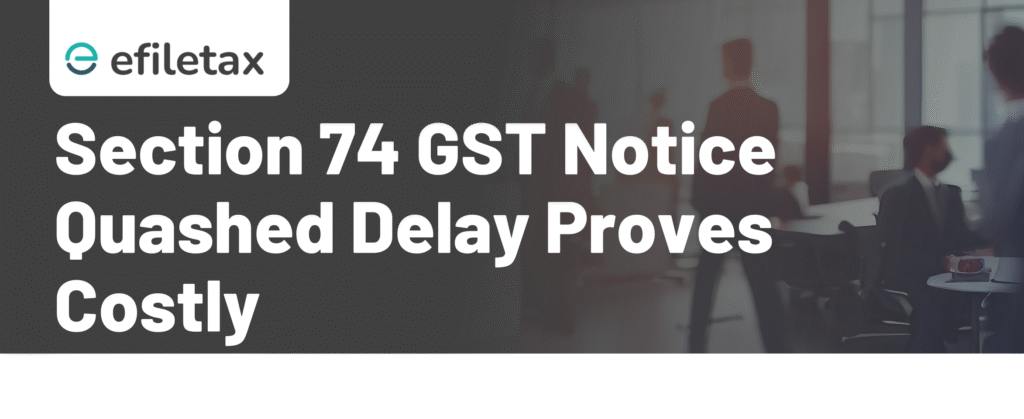
GST demand under Section 74 quashed: Key relief by Madras HC
Section 74 proceedings were recently quashed by the Madras High Court because the taxpayer was not provided with the certificate required under CBIC Circular No. 183/15/2022-GST. This judgment offers a strong precedent for GST payers facing recovery without proper closure of prior adjudication.
Let’s simplify what this means and how it impacts GST compliance.
What is Section 74 under GST?
Section 74 of the CGST Act, 2017 allows the department to recover tax where there is fraud, wilful misstatement or suppression of facts.
- Used for serious cases with intent to evade tax
- Involves demand of tax, interest, and penalty up to 100%
- Show Cause Notice (SCN) under Form DRC-01
- Final order in Form DRC-07
What is Circular 183/15/2022-GST?
CBIC’s Circular No. 183/15/2022-GST, dated 27th December 2022, was issued to ensure proper closure of tax proceedings under GST.
🔹 If a taxpayer pays tax voluntarily (under Section 73 or 74), the officer must issue an acknowledgment certificate in Form DRC-05.
Failure to issue this certificate creates confusion — and that’s exactly what happened in this case.
Case Summary: Madras HC judgment (2024–25)
In this case, the taxpayer had:
- Voluntarily paid GST dues under Section 74(5)
- Filed detailed replies to the SCN
- Requested closure based on Circular 183 and payment details
However, the department failed to issue the DRC-05 certificate acknowledging the payment and proceeded to issue a final demand order (DRC-07) after several months.
The Hon’ble Madras High Court ruled:
“Once the taxpayer has discharged the liability voluntarily and the circular mandates closure via DRC-05, continuing with Section 74 proceedings is not valid in law.”
Key Legal Takeaways
- Circulars issued by CBIC are binding on departmental officers (as per SC in Paper Products Ltd. vs. Union of India)
- Delayed or non-issuance of DRC-05 violates principles of natural justice
Expert Tip from Efiletax
If you’ve voluntarily paid GST dues under SCN and await closure, send a written reminder referencing Circular 183 and demand the DRC-05 certificate. Keep acknowledgment copies.
This can protect you from future harassment or double jeopardy.
Practical Guide: Responding to a GST Show Cause Notice
| Step | Action |
|---|---|
| 1. | Review notice under Section 74 (check SCN and facts) |
| 2. | If tax liability is genuine, consider paying with interest |
| 3. | Pay using Form DRC-03 before issuance of DRC-01 |
| 4. | Submit reply + payment details with proof |
| 5. | Demand DRC-05 certificate citing Circular 183 |
| 6. | Escalate via RTI/legal if certificate is delayed |
Subheading: Section 74 GST demand: What to do if DRC-05 is delayed?
- Follow up via email or physical letter to GST officer
- Quote Circular 183 and your DRC-03 payment date
- Attach payment challans, SCN reply copy
- If no response in 15–30 days, consider filing a writ petition in High Court
FAQs
Q1. What is DRC-05?
It’s a certificate issued under GST acknowledging full voluntary payment of tax dues, stopping further action under Section 73/74.
Q2. Is Circular 183 mandatory?
Yes, it’s binding on officers as per settled case laws.
Q3. Can I challenge a GST demand order after payment?
Yes. If you paid earlier and the officer continued proceedings without issuing DRC-05, you can challenge it legally.
Summary
Madras HC quashes GST demand under Section 74 due to non-issuance of DRC-05 as mandated by Circular 183. Know your rights if you’ve already paid your dues.
Final Word
This case is a big relief for taxpayers who voluntarily pay GST dues. The Madras HC has confirmed that once payment is made and Circular 183 is applicable, the department cannot continue proceedings without closing the matter.
👉 Facing a GST notice? Get expert help to draft replies, file DRC-03, and ensure compliance — all through Efiletax.